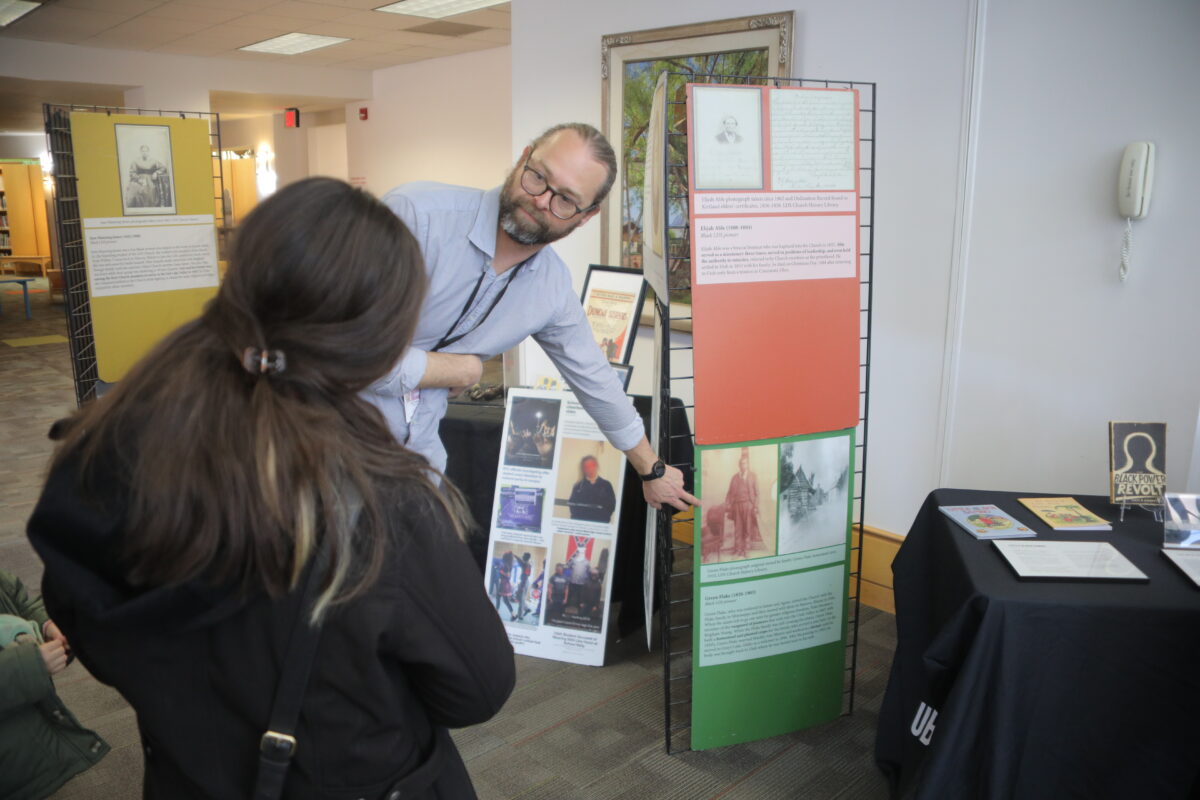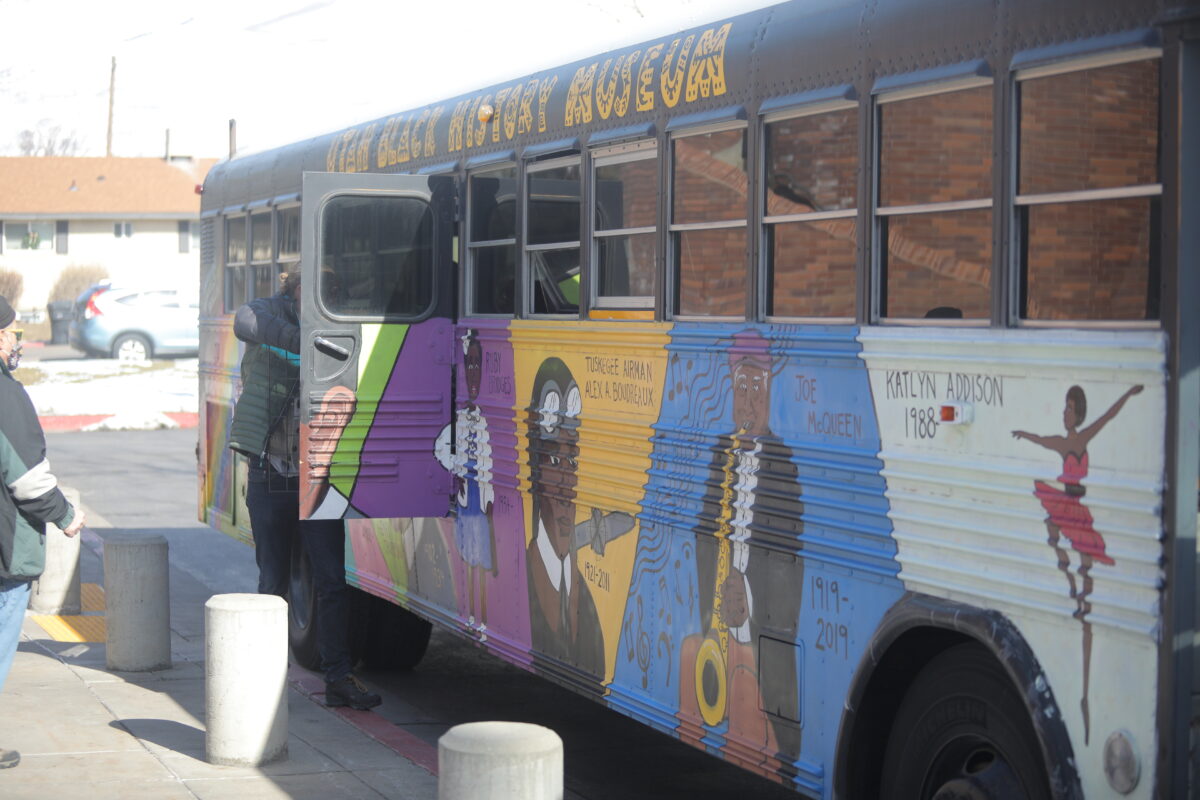Black History museum makes its first stop of 2023 at Orem library
- Nathan Robison points to a display on Green Flake at the Utah Black History Museum exhibit in the Orem Public Library on Saturday, Feb. 4, 2023.
- The Utah Black History Museum bus sits in the Orem Public Library parking lot on Saturday, Feb. 4, 2023.
- Rae Duckworth sets up exhibit tables for the Utah Black History Museum inside the Orem Public Library on Saturday, Feb. 4, 2023.
- A photo of a Ku Klux Klan rally held in Utah is shown at a Utah Black History Museum exhibit in the Orem Public Library on Saturday, Feb. 4, 2023.
- Beckham Forsyth, right, and Hazel Cottle examine a display on redlining at the Utah Black History Museum exhibit in the Orem Public Library on Saturday, Feb. 4, 2023.
- People walk through exhibits from the Utah Black History Museum in the Orem Public Library on Saturday, Feb. 4, 2023.
- Shaunte Zundel, center, teaches her children about all-skin tone bandages at an exhibit from the Utah Black History Museum in the Orem Public Library on Saturday, Feb. 4, 2023.
“I did not know that.”
That’s one of the most common reactions to the Utah Black History Museum bus and traveling exhibit, according to Rae Duckworth, head of Black Lives Matter Utah and a member of the museum’s board of directors.
On Saturday, the bus was parked in front of the Orem Public Library and inside, at the back of the library’s children’s section, was a four-table exhibit of artifacts, photos and books detailing Black history in Utah, alongside placards of historic information.
The museum bus was first unveiled in March 2021 and after seeing it in 2022, Nathan Robison, Orem’s programming and outreach librarian, along with other staff wanted to bring the traveling exhibit to the city. After the groups worked together through the fall, they made Saturday a reality — the first stop for the bus in 2023 over the first weekend of Black History Month in a city that’s 0.6% Black, according to the U.S. Census Bureau.
“Black Americans have contributed so greatly to the history of Utah, to the history of the United States and it’s just cool to have a have a program that highlights the contributions of so many Americans that many of us may not be familiar with,” Robison said. “We just think it’s a great opportunity to learn more about Utah history, about Black history.”
Originally, the plan was for the exhibition to be held within the Utah Black History Museum bus — housed inside a repurposed school bus. But due to accessibility concerns and issues with securing fragile exhibit items, it is instead set up in the venue the museum is visiting. For the Orem library, this meant a makeshift series of tables and display boards at the back of the children’s section.
Denee Tyler came to the exhibit after the announcement piqued her interest, though she told the Daily Herald she always makes time for programs at the library. As a transplant to the state, Tyler was intrigued by the tales of Black people in Utah through the 1800s, but made sure to examine everything available.
“I’m aware that this was around but it’s always kind of upsetting to see,” Tyler said, gesturing to a display of minstrel show-painted children’s toys.
Along with the minstrel toys were displays of Black children’s dolls, books on race and other Utah-specific artifacts. On the second table sat a promotional poster and place setting for Coon Chicken Inn, a series of restaurants that included a racial slur in the name and minstrel imagery, first founded in Salt Lake City in 1925. On the other end sat an item that, Duckworth noted, regularly makes people uncomfortable.
Whether they look away quickly or even put it face down, people struggle to look at a photo taken at a Ku Klux Klan rally in Utah. Even Saturday, eyes grew wider on attendees when faced with the photograph.
“I think the truth is really hard to swallow. The truth is really hard to look at sometimes,” Duckworth said. “We have it in colorful pictures. We have it blown up in images and we have artifacts that are 3-D and, you know, they’ve been around a long time — they carry a lot of pain.”
Three kinds of poster board displays are also used with the museum. Some detailed Black Utahns integral to the state’s history, from Green Flake and Emma Manning, both early members of The Church of Jesus Christ of Latter-day Saints, to Joe McQueen, the jazz music icon and Ogden native who died in 2019.
Knowing the names, according to Duckworth, is just the start.
“What do you know about these names, though, is my favorite thing. Because you can know names, it’s very good to know names,” she said. “But do you really know them?”
Flake is one person featured in the exhibri who sticks out to Duckworth. Labeled as a pioneer, she hopes people can build on that, connecting with his reality as an enslaved person while pioneering the Utah Territory.
E.J. Caceres, an Orem library employee who brought her children to see the exhibit, appreciated learning about the state’s founding and early days beyond what was taught in her Utah history class, even if it led to difficult conversations.
Others posters focused on moments in the state’s history and how they affected Black residents, then and today. Boards taught children and adults about the history of redlining in Salt Lake City, the Black 14 football players from the University of Wyoming and “The Last Lynching of the West.”
“I didn’t know Brigham Young was pushing for slavery here in Utah. I did not know that. For my kids, they learned what lynching meant. They didn’t know what lynching meant so we had a little conversation about that,” Caceres said.
“The Last Lynching of the West” refers to the 1925 hanging of Robert Marshall, a Black coal miner accused of murdering a police officer. According to the display, no witnesses would testify against the 11 men arrested for the crime and charges were dropped despite photographs of Marshall’s body being sold for 25 cents each.
Despite the painful history and present — shown with a compilation of news headlines regarding racism in Utah schools and a small display of Izzy Tichenor, the Black 10-year who died by suicide after experiencing bullying in her Davis County elementary school, her mother says – Duckworth has hope for people, especially after they see the exhibit for themselves and absorb the information.
“I want everyone to come here and see these things, understand the truth that they carry, the pain that they carry,” she said. “We love you for coming, we love you for taking time, we love you for being uncomfortable for the five minutes that you might have been here.”
Additional Black History Month programming scheduled for the Orem Public Library includes a Feb. 27 African Cultural Celebration, which will include poetry, dance, storytelling and music.
The Utah Black History Museum bus will continue visiting schools, libraries and museums around the state, including a stop at Utah Valley University on Wednesday. Those interested in requesting the bus can do so at http://ubhm.org/.

















